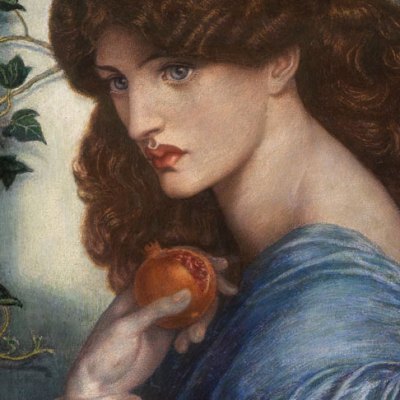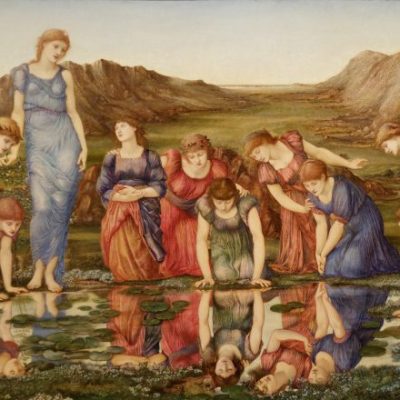J.W. Waterhouse (1849–1917) wanted his painting Hylas and the Nymphs (1896) to attract public attention, and so it has for much of its existence – not least in the last month following the work’s temporary removal from public display at Manchester Art Gallery. But its premiere did not go as planned. A perfectionist who worked slowly, building up his pigments in many layers, the artist occasionally missed submission deadlines, as he did with Hylas. Quiet yet ambitious, he had intended to show it at the Royal Academy’s 1896 Summer Exhibition to mark his election to full membership there the summer before. In its March 1896 issue, the Studio magazine – always supportive of Waterhouse– dutifully heralded its imminent premiere in London.
Having missed the RA’s deadline, Waterhouse needed to place Hylas in an autumn exhibition, and might normally have chosen Liverpool had the well-funded Manchester City Art Gallery, as the museum was then called, not pre-emptively purchased it for £800 in July 1896. Renowned for buying glamorous paintings, Manchester premiered Hylas in its own annual exhibition that autumn. The following April, the gallery sent it to the Royal Academy, where it was much noticed in a Summer Exhibition that featured so many water-women a critic dubbed it ‘the Mermaid’s Cavern’. As the show opened, the critic A.L. Baldry dedicated an entire article in The Studio to Hylas, even illustrating three of Waterhouse’s preparatory drawings for the nymphs.
Now that they owned another famous painting, the Manchester gallery’s administrators intended to show it off regularly. Waterhouse himself was oddly retiring on such matters: in January 1899 he wrote to his fellow Academician E.J. Poynter that he ‘had no intention of sending anything to [the 1900 Exposition Universelle in] Paris… As however you say it is important I should be represented, the only picture I can think of is [Hylas].’ With Waterhouse’s support, Manchester sent its painting to that fair, then to Glasgow’s World’s fair in 1901, St. Louis’s in 1904, and London’s Franco-British exhibition in 1908. Why? Because, in the words of the critic Claude Phillips, Waterhouse was one of Britain’s leading ‘moderates of modernity’ – those who embraced ‘the modern French standpoint’ without disregarding ‘the face of English art’.
A Naiad (1893), J.W. Waterhouse. Private collection

Because he left no archive and was rarely quoted in the press, it is difficult to establish Waterhouse’s own view of Hylas and the Nymphs. Clearly it sustained his Symbolist fascination with what the friendly critic M.H. Spielmann called the ‘sweet girl-fatalist’. (Spielmann was describing two slightly later paintings – Flora and the Zephyrs [1897] and Ariadne [1898] – but could just as easily have meant Hylas.) In 1893 Waterhouse had depicted her in La Belle Dame Sans Merci, A Naiad, and A Hamadryad. Thanks to Keats, viewers knew that the maiden of La Belle Dame Sans Merci is dangerous, but the nymphs in the latter two works had more ambiguous intentions. Hylas, A Naiad, and A Hamadryad all underscore Waterhouse’s interest in the ‘lower’ pagan gods, nourished by his deep reading of Ovid and Shelley, and possibly of John Addington Symonds, who argued in his Studies of the Greek Poets that humans harbour ‘within our souls some primal sympathies with nature, some instincts of the Faun, or Satyr, or Sylvan, which education has not quite eradicated’. The rising tide of Pan-related art and literature signalled a Romantic resistance to the joylessness of modern Christianity, science, and alienation from simple pleasures of the land. Sadly there is not enough space here to review the considerable evidence pointing to Waterhouse’s own occultism, which Baldry alluded to delicately as a ‘definite inclination toward a picturesque mysticism’.
A Hamadryad (1893), J.W. Waterhouse. Plymouth Art Gallery

Keenly as Waterhouse may have ‘felt’ A Hamadryad and A Naiad, these subject-less pictures proved awkward for critics to describe with words. Thus they did not attract much attention and never sold in Waterhouse’s lifetime. Surely now he could see that his income depended on conveying his mysticism through images of young women in more familiar, easily describable narratives. Relevant examples include Ophelia (1894) and Saint Cecilia (1895), both of which sold to the ‘Silver King’ George McCulloch, a university-educated Glaswegian who made a fortune in Australian mining and retired to London in 1892. By his death in 1907, he had spent (mostly through Agnew’s) at least £250,000 on more than 300 contemporary British and continental artworks, installed in his luxurious new Kensington house, a monument to conspicuous consumption. McCulloch was one of many rich collectors who admired Waterhouse in the 1890s; when the artist wasn’t selling his major pictures to museums (e.g., Melbourne, Adelaide, Leeds), they were going to such industrialists as Charles E. Lees (Oldham), Alfred de Pass (Falmouth), and James Murray (Aberdeen). These men knew something of classical myth and romantic literature, but presumably were more interested in the beauty of the composition, and of the people depicted in it.
Hylas’s tale offered Waterhouse an ideal solution: a recognisable narrative that featured attractive figures and also conveyed his vision of nature’s enchantment. It depicts the climactic scene of a story told by Ovid and other ancients, familiar to most Britons with even a basic classical education. (The tale’s place in British culture is suggested by references to it in Spenser’s The Faerie Queene, Marlowe’s Edward II, and Wilde’s The Picture of Dorian Gray.) Herakles, having killed Hylas’s father, raised the orphan as his son and lover. Both sailed with Jason on the Argo, which stopped on an island. Sent for fresh water, Hylas was lured into the pond by naiads and drowned. But their culpability is not a foregone conclusion in Waterhouse’s treatment, which instantly rivets our attention on the desirous gaze exchanged by Hylas and the most insistent nymph.
Hylas and the Nymphs (1896), J.W. Waterhouse. Manchester Art Gallery

More than any artist who had treated this subject before, Waterhouse thought deeply about the simultaneous natural-ness and supernatural-ness of nymphs emerging from the feminine element of water he depicted so often. ‘Nymphaea’ is the botanical name for white water-lilies, and so these nymphs are naked and identical: numerous studies on paper confirm that all seven were sketched from just two models. They constitute Waterhouse’s interpretation of the Symbolist motif of deadly, long-tendrilled flowers rising from water, best known in England through Aubrey Beardsley’s illustrations of the early 1890s. Many critics found Waterhouse’s nymphs melancholy, but A.G. Temple, then director of the Guildhall Art Gallery in London, admired ‘the sweet and winsome expression that, not without a touch of wonder, is on the countenances of all’. Waterhouse eroticised the nymphs not through their faces, but through the arrangement of their torsos and arms. The term ‘nymphomaniac’ had been used since the 1860s to describe the perceived abnormal interest of certain women in sexual gratification, and could have occurred to some educated viewers. Many instinctively assigned blame to the nymphs by recalling earlier representations that showed Hylas attacked, including Pompeiian artworks and the renowned sculpture of 1837 by John Gibson RA. But here, in Waterhouse’s treatment, the tension between the nymphs’ innocence and sensuality makes their enchantment of Hylas both logical and unforgettable; even if one has never seen it before, Hylas resonates like – in the words of a critic writing in 1897 – ‘a vague memory’.
La Belle Dame Sans Merci (1893), J.W. Waterhouse. Hessisches Landesmuseum Darmstadt

Like the knight in La Belle Dame, Hylas is figuratively disarmed by an ominous stalk as he gazes down on a flower-like face. The critic A.C.R. Carter saw in Hylas’s figure ‘all that love of anatomical beauty in which Leighton revelled’, a fact which justifies the nymphs’ desire and may arouse the viewer’s, too. Baldry thought Waterhouse ‘put into pictorial shape an entirely poetical motive, which is at the same time absolutely free from any taint of that sentimentality which is too often substituted by modern workers for deeper intellectual qualities. Mr. Waterhouse’s composition is dramatic, but its drama is a matter of subtle touches rather than an obvious and exact setting forth of a story. […] The artist has felt the romantic possibilities of the subject, and has regarded it in the right spirit. […] Mr Waterhouse becomes in this work an apostle of the delightful Paganism, by the loss of which so much that is beautiful has been taken out of life.’
The semicircle of nymphs appears accidental in formation, but it is significant that there are seven, the same magical number seen in Waterhouse’s successful Ulysses and the Sirens (1891). The voyeuristic pleasure of observing a seduction still appeals, and the erotic intensity is balanced perfectly by Waterhouse’s characteristic stopping of the narrative at what the critic Rose Sketchley called ‘pictorial and emotional equilibrium’. This stasis is even more remarkable in view of the episode’s traditional depiction as violent.
Ulysses and the Sirens (1891), J.W. Waterhouse. National Gallery of Victoria

Critics differed in assessing the nymphs’ culpability. Some saw women dragging a man from his earthly element into their dark, watery grotto: Carter complained that Waterhouse ‘suggests none of that gladness which the classic legend’s undercurrent of blissful immortality contains’. This comment raises the characteristically Symbolist question of whether Hylas, like a fin-de-siècle Decadent, had in fact abandoned himself to pleasure, to ‘live’ in ecstasy forevermore. Spielmann felt that the nymphs ‘have such wistful faces and delicate forms that we find ourselves wondering if’ we pity Hylas. Most critics compared the nymphs to Burne-Jones’s, but J.E. Phythian, director of Manchester’s gallery, drew a crucial distinction: ‘Burne-Jones retold these old-world stories with little or no realism. Mr. Waterhouse retells them as one would do who believed them.’
In 1895 the critic R. Jope Slade reported that, despite Waterhouse’s status as ‘a painter’s painter, he has always enjoyed an astonishingly broad popularity’. Hylas premiered a year later and advanced the artist’s popularity considerably. In 1897, in the catalogue accompanying a popular, if conservative, exhibition at the Guildhall summarising Victorian painting, Temple titled his sixth chapter ‘Watts, Leighton, Poynter, Tadema, Waterhouse, Dicksee’. This linking of six distinct personalities has more to do with the sweeping scope of Temple’s project than it does with the artists themselves, yet it confirms Waterhouse’s universal recognition in the 1890s as a modern master.
Nothing lasts forever. In 1925 the Manchester City Art Gallery sent Hylas and the Nymphs to the British Empire Exhibition at Wembley, the very last gasp of British imperialism and academic art. The following year it was transferred from the main gallery in central Manchester to its Queens Park storage site, where it remained until the 1960s, except for six years (1928–34) at the gallery’s Horsfall branch in the working-class district of Ancoats. During this, the heyday of modernism, it is fortunate the gallery did not sell off Hylas, as the Royal Institution of Cornwall did with Waterhouse’s Pandora, originally a gift from de Pass and now owned by Andrew Lloyd Webber. Hylas has been a mainstay of Manchester’s Victorian displays since the 1960s, and its adventures this winter have now brought its fame fully into the 21st century. Waterhouse would surely have been delighted that Hylas still matters to the public he always aimed to inspire.


